With the wealth of information and resources readily available online combined with frequent media reports about unethically produced fashion there is absolutely zero excuse to continue supporting ridiculously cheap brands and yet these unethical companies continue to thrive and expand while the people actually creating the garments live in extreme poverty. This is a frustrating never-ending cycle that can only be broken by consumers making a conscious choice to say “no” and stop buying the unethical products until changes are actually made and not just promised for some random time in the future. Sadly the average shopper simply doesn’t care.
Reusing, upcycling, refashioning and shopping second hand are fabulously economical alternatives for creating your own unique, trendy style without supporting the corrupt companies behind impossibly cheap fast fashion however, is thrifting really ethical?

Discover my views on this controversial topic and then share your thoughts in the comments below:
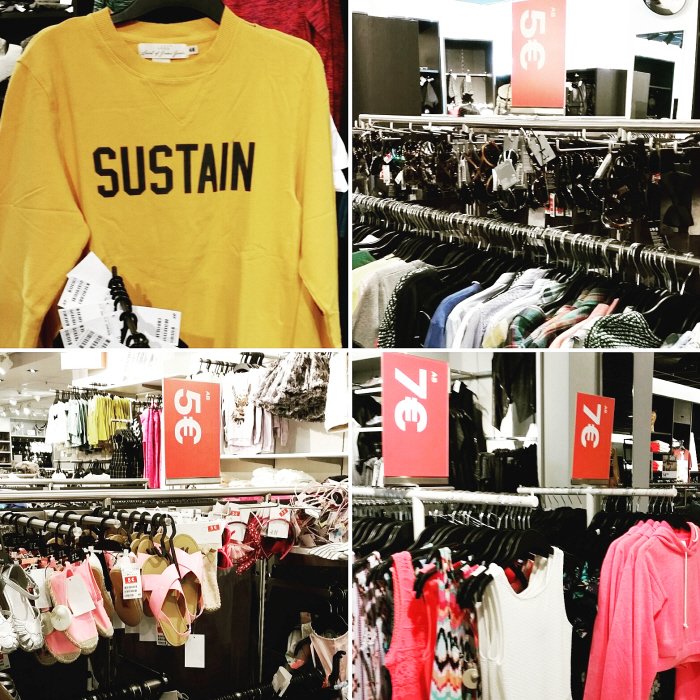
We all know that attempting to find 100% ethical and sustainable products in regular stores is a challenge. Even with the searchable resources and detailed brand reports provided by The Fair Wear Foundation and The Clean Clothes Campaign there are no guarantees that the garments were actually manufactured under ethical conditions.
Unfortunately stitching up your own clothing from new textiles is also an ethical gamble as most of the material in fabric stores is manufactured in similar conditions to fast fashion.
Unless you are buying something that is clearly marked as ethical and sustainable you can be pretty darn sure it is not. Companies who actually care enough to take the time and spend the money to ensure that their products are ethically and sustainably produced absolutely shout it from the rooftops, add it to the tags and proudly display extensive information about their production methods and labour policies on their websites.
Thrifting is most certainly a sustainable way to shop but is it also ethical?
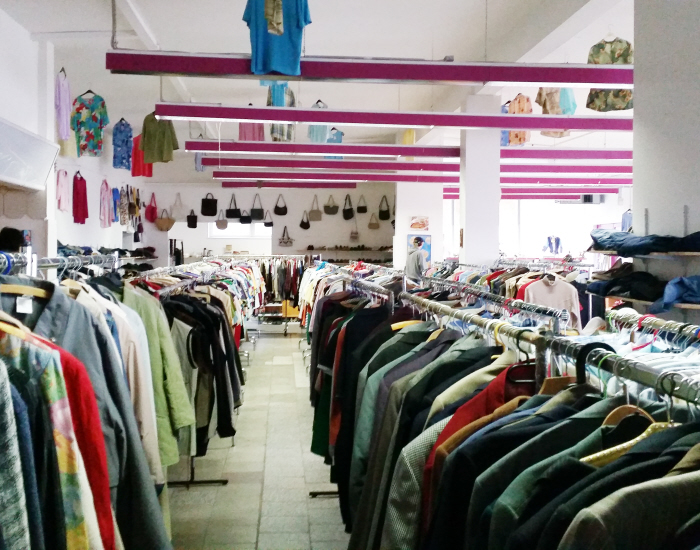
In my opinion it is. By shopping second hand and reusing I am not contributing a penny to the multi-billion dollar fashion industry nor am I unintentionally supporting an unethically produced brand.
But what about second hand fast fashion? Buying fast fashion at thrift and charity shops is definitely a personal choice. On the one hand the money is no longer going into the pockets of the unethical brand but on the other hand, you’re still a walking advertisement for the company when you wear the mass produced, recognizable garments regardless if they are second hand or not. (I’ve made a conscious decision to steer clear of fast fashion brands entirely – knowing that a garment was most likely created unethically is more than enough to reason to leave it behind and hunt for something else.)
Unfortunately there are absolutely zero guarantees that any garment from any era was 100% ethically produced. The unethical treatment of garment workers has been happening since mass produced clothing was invented. Unscrupulous companies have (& will) always find a way to cut costs regardless of labour laws and sadly illegal sweatshops can be found in every country in the world.
Outsourcing the piecework to factories in poor countries began in the mid-1970’s and from there unethically produced “fast fashion” truly began and had completely changed how the general public shopped for clothing by the 1990’s. The rise of the internet has finally given garment worker rights activists an open, worldwide platform to spread the ethical/sustainable fashion message and educate the buying public about just how and by whom fast fashion is made and the actual costs involved behind their throwaway-and-buy-more clothing & accessories. The sad truth is that the average consumer simply doesn’t care and the instant gratification of scoring a new steal of a deal item is more important than pausing to think about who made the garment.
What do you think? Is thrifting really ethical? Let me know in the comments below…
and if you’re still on the fence about thrifting and shopping second hand take a peek at my Why Not Thrift? video and meet my amusing cast of characters and discover why thrifting and reusing should be an important part of everyone’s life:
Disclaimer: I am not at all an expert on the big business of fast fashion however I am a concerned consumer who has chosen to learn & share as much as I can through my own personal experiences & the wealth of resources available online.
Discover how to use what you have to create what you want at RefashionistaSheri.com
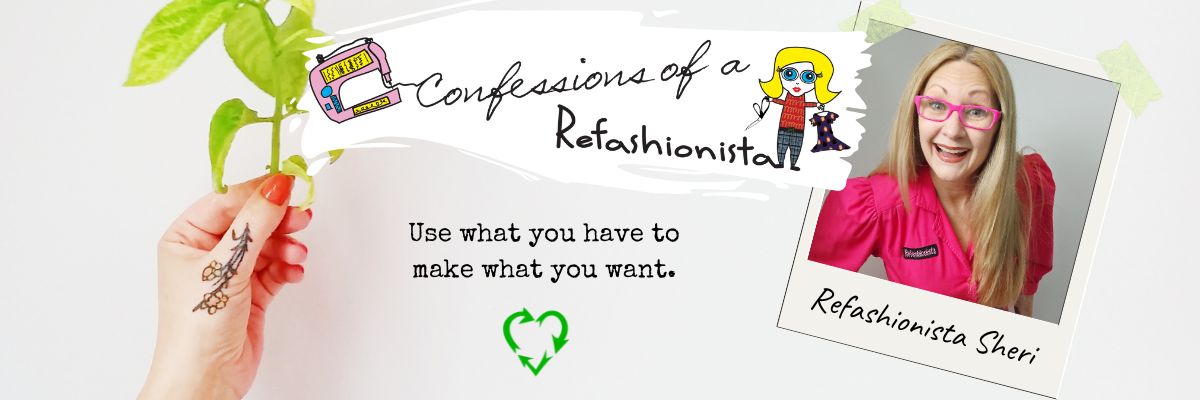
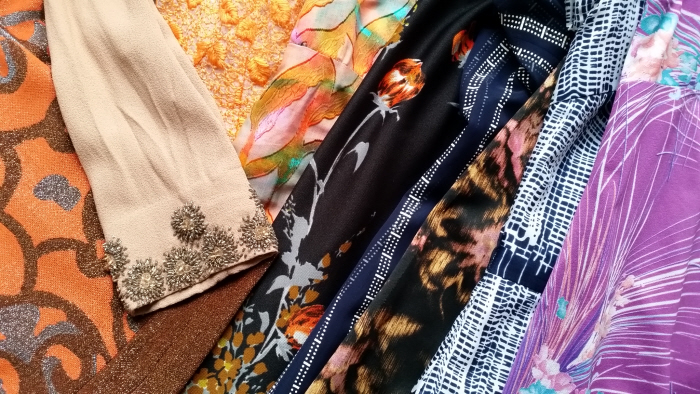
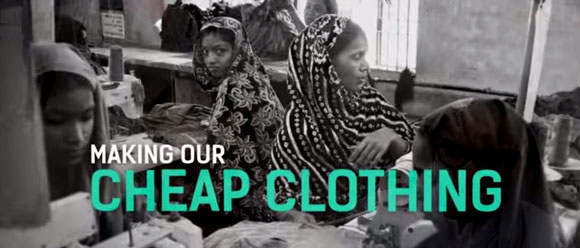
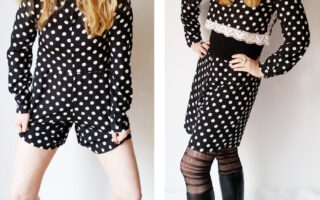


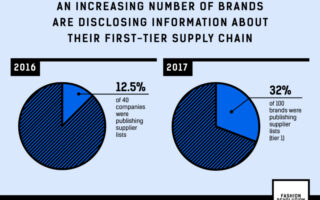


I buy and wear predominately second hand clothes and this is my preference for a number of reasons. It’s not really about saving money but I do feel that I am saving items from being wasted. I normally avoid cheaper brands but this is mainly a matter of snobbery rather than ethical considerations. While I am prepared to pay more for items I really want, nobody wants to feel ripped off and I agree with the comments about the prices in some charity shops being to high. I am likely to spend more money in a shop where the items are cheaper and just walk out if I think they are over priced. I also don’t make any decisions based on the relative merits of charities and buy only on the basis of the goods on offer. I acknowledge that I already have plenty of clothes already and don’t actually need to own any more at all – I should probably take one of those ‘nothing else for a year’ type challenges and am also confident that many people who claim to have to shop second hand due to lack of money have also already got plenty of clothes. I now look on charity shopping and refashioning as an enjoyable and fairly harmless hobby.
My daughter was a charity shop manager for about a year, prices were at the low but not giveaway end and her view was that volunteers like to sell things and better to lower the prices a little to facilitate that – all shops have more donations than they can possibly sell anyway. It was also a mistake for shops to filter out anything of value and sell it off on ebay because shoppers are more likely to return where they have seen something of quality even if it was not for them on that day.
I absolutely agree that some so-called thrift stores overprice their donated merchandise however it is also a sad fact that charity and thrift shops are now having to attempt to compete with the ever-dropping prices of unethical fast fashion.
During my 8 years spent living in Berlin I was fortunate to find 2 honest to goodness “real” charity shops where the prices reflected the massive amount of donated stock the organizations were attempting to sell and the money went where it was supposed to. Since returning to North America I’ve definitely had my fair share of raised eyebrows when sifting through the racks of the large chain thrift stores but the small stand-alone charity shops still seem to have their priorities and pricing on point for the copious amount of donated stock they receive.
It’s fantastic that you are in a position to be able to view charity shopping and refashioning as a “fairly harmless hobby” 😀 Unfortunately there are loads of people throughout the world who rely on thrift and charity shops to be able clothe their families and furnish their homes (kiddo’s frequently outgrow clothing & shoes + adults should be able to have a new to them item regardless if they have plenty of clothes or not).
It is a bit frustrating when thrift shops cherry pick their donations to sell online for much higher prices than they would get instore however if that money does in fact go to supporting a charitable need it should be a positive result. It’s awesome when charities combine their brick and mortar store with an online presence as well. Thrifting online is (almost) as fun as going to the shop. 🙂 http://awesomesauceasshattery.com/2015/02/03/thrift-online-top-tips/
I make a conscious effort to not thrift fast fashion brands. I often try to find true vintage pieces that were produced in my own country or in the U.S. This is not always possible. I have very few fast fashion brands and agree with some of the other comments that at least we are keeping these pieces out of landfill. I also try and support the non-profits in my area by both buying from them and donating to them. The for-profit thrift stores are plentiful and let’s face it, they are in the business to make money. My closet is in constant rotation. I bring things in, I take things out and donate them. The one consolation about these for-profit stores is that at least they are paying the non-profits for the pick up of donated items (at least that is how it works where I live-stores like Value Village at least will pay the Canadian Diabetes for donation pick up). It’s a greedy, greedy world we live in. I do not however, feel sorry if I happen upon something that ended up costing me very little. We are a family of 5 (2 in university) and really try to live ethically in more ways than one. I also volunteer in my community and sorry to the poster who says she can’t stand it when people write about how very little they got something for at a charity shop. Please consider that most of these people are actually making a tremendous effort to do the right thing. There are constant sales going on to MOVE MERCHANDISE. This is the whole point! If I find a great deal, heck ya I’m going to write about it on my blog. If that gets somebody to consider doing what I do and stop buying fast fashion and start buying thrift, well I can only think it’s a win-win.
Well said Vee. Unfortunately there are loads of people who automatically assume that bloggers who to take the time & effort needed to present their work in a professional manner are well off and shop at thrift and charity shops simply because they are “cheap” and not willing to spend more, which is absolutely not the case at all. I’ve learned to take the mountains of aggressive (& abusive) messages I receive from these thoughtless people as grand compliments on my creativity, talent and ability to transform thrift store items that no one else wants into fabulously stylish outfits and completely unique wardrobe favourites that are well within my very limited budget yet look like a million bucks!
I cannot count the number of times I’ve actually been thanked by the staff of the charity shop that I frequent for buying items that they thought would never sell, they even check my blog to see how I upcycle my purchases and are always ready to share their thoughts on my latest refashions during my next thrifting trip 🙂
On a side note: There is an ongoing problem with the ethics and legalities of donation containers in Germany. At present there are over 10,000 of these “charitable clothing recycling containers” throughout Berlin, unfortunately many of them are actually owned by for-profit, globally active second-hand trading firms. The bulk of the “donations” these firms receive are from people who are unaware of the fact that they are feeding their unwanted goods into a huge, multi-million-euro industry.
Those donation boxes-yes, they are all over Ontario as well and you wonder where all that stuff ends up! It’s up to the individual to become informed, especially with the practices of for-profit corporations like Value Village whose family are billionaires. They make a HUGE profit off of donations where the charities that collect the donated goods from them make very little. At least that is my understanding. I am selective when I donate. I try to see what’s needed in each of the non-profit stores and will take what I think they need to them. I also tend to give them the “better” stuff so they can make more money. I admit though that I do still donate to places like Value Village because they give me a discount, which I have to be honest, I really do appreciate. At the very least, I’m not just dumping stuff in the trash. At least the charities associated with them get something, but hands-down I prefer to give to charitable organizations. Being thrifty is not about being cheap or gloating about fab finds at a hugely discounted price. It is about being smart, being environmentally conscious and educated and truly trying to make an effort to do the right thing. That is amazing that your stores follow your blog to see what you create. Love that!
To play Devil’s Advocate: If we stop buying ‘fast fashion’, clothing manufacturers will still want to make the same profit. They will achieve this by squeezing workers’ wages. Alternatively the less we buy, the fewer people will be employed in the garment industry.
I don’t condone low pay and poor conditions in any country or any industry but isn’t it better to work for a low wage than have no wage?
This “devil’s advocate” reasoning by consumers is exactly what the billionaires behind unethical fast fashion brands rely on to be able to continue taking gross and immoral advantage of their garment workers.
Sure, a low wage might be better than no wage but why is a living wage so impossible to pay for these huge, wealthy international companies? And why is that cheap fast fashion dress more important to the average shopper than standing up and ensuring that the people who made it earn a living wage and work in safe conditions? Consumers who continue to buy unethical fashion are indeed not only condoning but also supporting the immoral labour practices of the brands.
A garment worker’s wage is only 1% to 3% of the total cost of most clothing – this is deplorable.
Stop and think about that for a moment and tell me how adding a mere 1% – 3% more to the cost of a garment could possibly be negative or even noticeable for the consumers or the brands? However that 1% – 3% more would make a massive difference to the lives of the garment workers.
If a brand sells a shirt for $10 the worker who made it received 24 cents at most. Doubling this wage would only be another 24 cents. Consumers would barely notice this type of increase, and if a consumer won’t notice it, a massive wealthy company definitely won’t suffer profits from it. These types of costs could easily be absorbed into the profit margins of these billion dollar brands.
At present garment workers in Cambodia are being beaten, jailed and even murdered for marching and demonstrating to be paid the barely living wage of $177 per month (the current average garment worker wage is only $120 – $140 per month which is well below the average living wage of $185) and it is preferable to be employed as a prostitute than a garment worker in the Philippines. This harrowing documentary about garment workers in the Philippines by Vice News’ founder Surrsh Alvi is a must watch for anyone who buys fast fashion: https://news.vice.com/video/the-high-cost-of-cheap-clothes
The 10 Biggest Excuses For Not Paying a Living Wage (And Why They Suck) by The Clean Clothes Campaign is an absolutely brilliant article which debunks the illogical reasons companies (& consumers) use for not providing a living wage and safe working conditions to garment workers. Numbers 5 & 6 (see below) are my faves, check out all 10 in the original article here: http://www.ecouterre.com/10-biggest-excuses-for-not-paying-a-living-wage-and-why-they-suck/clean-clothes-campaign-sweatshop-excuses-2/
5. WE’RE HELPING WORKERS WHO WOULD OTHERWISE BE UNEMPLOYED
It’s true that, for many workers, getting a job at a garment or sportswear factory is better than some of the alternatives—that’s why so many depend on them. The fact that people are desperate isn’t an excuse to exploit them. Workers aren’t getting their fair share of the benefits they are creating for the big companies.
The fact that people are desperate isn’t an excuse to exploit them.
We welcome the fact that millions of people are earning a wage. This alone, however, is not enough to lift them from poverty if employers can hire and fire at will, deny union rights, pay low wages that drive people to work inhumane hours just to survive, avoid paying sick leave, and avoid
observing maternity rights.
For many workers, these jobs carry devastating hidden costs, such as poor health, exhaustion, and broken families, all of which are unacceptable and avoidable.
Everyone wants and is entitled to a quality job that pays “just and favourable remuneration ensuring for himself and his [or her] family an existence worthy of human dignity,” per Article 23(3) of the Universal Declaration of Human Rights.
6. THE COST OF LIVING IS LOWER OVER THERE SO WE CAN PAY WORKERS LESS
Of course it’s true that the cost of living in many countries is much lower than in the United States and Europe—that’s why we don’t compare our wage levels with workers elsewhere. We do know from our partners around the world, however, that the minimum wage in each country is never enough to provide a “living” wage for workers and many garment workers don’t even get paid the minimum. A garment worker in Cambodia has to work two hours to afford one kilo of rice. The same worker in Norway can buy 14 kilos for just an hour of work.
A report from Norway’s Future in Our Hands revealed that garment workers in Bangladesh and India have to work approximately for three hours to be able to buy one kilo of rice. Garment workers in Cambodia have to work two hours to buy the same amount of rice while in Shenzhen, China, one hour’s work is enough. As a comparison, a garment worker in Norway can buy 14 kilos of rice for one hour of work.
A living wage enables workers to meet their needs for nutritious food and clean water, shelter, clothes, education, healthcare, and transport, as well as allowing for a discretionary income. It should be enough to provide for the basic needs of workers and their families, to allow them to participate fully in society and live with dignity. It should take into account the cost of living, social security benefits, and the relative standards of other groups. This is what we believe each worker should be able to earn within a normal working week and this currently isn’t the case.
I do voluntary work at a social centre where we sell second-hand donated clothes twice a week. The profits are used to buy the food we distribute to people in need. If you are not willing to pay more than 1 Euro per piece, that means we have to sell at least 2.000 pieces of clothing in order to come up with the funds we need in a month. It is really hard work for our volunteers (mostly retired people who look for a sensible way to spend their time) because we estimate that we move up to 8 tonnes of stuff per year. That’s why it doesn’t sit particularly well with me if people write in their blogs how they scored their stuff for 50 cents and I decided to personally pay more if I find something I really want to have.
Thanks for your comment Ursula. Throughout my life I have volunteered at several charity shops, homeless shelters, soup kitchens and nursing homes and from my own personal experiences I am well aware of the amount of hard work involved behind the scenes of these fabulous organizations.
Shopping at thrift and charity shops is not only my personal choice for creating an ethical wardrobe but is also a necessity as we are a low income family and simply cannot afford to purchase brand new ethically produced items from sustainable brands.
As I stated in my previous comment, the Sozialladen I frequent provides “discount days” twice per month in which books & glassware are sold for €0.10 each and textiles & clothing for €0.50 – €1 each. This is not only wonderful for people with a low income (& growing kiddos) but is also how this particular charity shop clears out old items to make room for the new stock and donations they receive daily.
My ambition to inform and influence others to step away from unethically (& immorally) produced products is the driving force that motivates me to continue providing free eco-fashion, accessory and upcycled home decor tutorials + sustainable style inspiration and helpful thrifting tips on my Confessions of a Refashionista & Refashion Nation blogs as well as contributing and sharing my creative skills throughout the online maker world. I am proof that unique, sustainable, ethical style can easily be achieved on a very low income with a bit of creativity and imagination.
We went on a thrifting spree last Saturday with my hubby, and by the end of the day, I was mad. First, there are very few thrift shops in our area, so we had to pretty much drive across town to get to the next one. Secondly, the prices at which those fast fashion items are sold in thrift shops is just ridiculous. I’m seeing a trend where thrift shops are getting more and more expensive and it drives me mad, because why would people buy used fast fashion items (and lets face it, most of them are) at higher prices than they could buy brand new items. I get it that the consignment shops also have to pay their employees, and with fewer people visiting them, they have to price up. Meanwhile, the storm of people I see shopping whenever I pass by an H&M is just mind-blowing. Things are just messed up!
I was looking for a maternity-friendly dress, and found one that was a decent fit. Originally from Zara, and it cost 24€. I was like “Are you f*king kidding me?” and walked away. So, I’m going to refashion something today from a dress I already had in my stash.
100% spot on Hanna! Unfortunately thrift and charity shops are now forced to compete with the crazy prices of fast fashion and rarely appear to have any idea that they’re actually pricing used, donated items higher than they were originally purchased new. Harumph!
**Quick tip: when thrifting in Germany do a google search for “Sozialladen” + your post code to find the honest to goodness “real” charity shops in your area. In my experience stores that have “thrift”, “secondhand” or “vintage” in their names are actually not proper non-profit charity shops that benefit those less fortunate but are instead overpriced, for-profit businesses that take advantage of donations to make a tidy profit. This is a particularly bad problem in Berlin: http://www.exberliner.com/features/second-hand-scam/
My fave Sozialladen has prices starting from €0.10 and I rarely pay more than €1 or €2 for my groovy gear. They also have special €0.50 & €1 days on various items twice per month, yay! 😀
You have to buy clothes somewhere if you’re not making your own yarn and creating them yourself, so I think thrifting is a more ethical choice. Even the “for profit” thrift stores buy their goods from non-profits that don’t have stores but they do collect items, so either way, you’re helping out a charity.
Absolutely! As the average shopper can’t afford to pay the expensive designer prices of ethically produced sustainable brands thrifting is most certainly the best alternative to unethical fast fashion.
1. Keeping clothes out of the landfill
2. All profits helping people struggling with poverty, mental health problems, addictions, abuse and domestic violence
3. Providing retail training and volunteer opportunities for people struggling to enter the job market or needing volunteer hours for school
4. Providing a local community charity option for people to donate their clothes, blankets and accessories
Makes sense to us!
Yup, (most) thrift and charity shops provide fantastic services and opportunities to help those less fortunate which makes it so incredibly frustrating that the average consumer chooses to buy impossibly cheap unethically produced fast fashion instead of thrifting and shopping second hand to not only create a sustainable, ethical wardrobe but also support the charities and organizations behind the stores.
I love this ♡
My thought process is by thrifting (or swapping) all my clothes, I am not contributing to fast fashion. I too mostly steer away from the brands that I think may be the worst. I refuse to wear any brand that has their logo all over the exterior.
I have one of the *buy per pound* thrift stores near me – it’s great for my wardrobe! (Not great for my storage capabilities in my apartment though!)
Brilliant! I can’t wait to finally move back to Canada and visit the “by the pound” shops again! 😀
I like to buy vintage pieces especially Canadian made as much as possible so that I am not contributing to fast fashion as much as possible, even thrifted. But it is not always easy to find these pieces so I do buy thrifted fast fashion as well. I figure I am keeping these pieces out of landfill and not contributing directly to these corporations who pay their workers a pittance and force them to work in unethical and unsafe work environments. I try to buy my fabric for sewing thrifted as well which is awesome because you find the most interesting fabric that way. I also sew with vintage sheets and linens thereby keeping these beautiful textiles in rotation. It is hard sometimes to avoid buying retail fabric and notions as I can’t always source what I want at the thrift store. But in an effort to keep my contributions to these companies at the low end, I buy remnants of fabric at huge discounts. Let’s face it, I’m cheap and frugal and for me, that is the primary key right up there with finding vintage or well loved pieces. Cheers, Michele
Too true Michele! Thrifting fabric and sewing notions is fantastic – they ARE so very beautiful and unique! I’ve managed to score loads of groovy vintage threads and sewing gear on ebay and have even lucked out at the thrift shop with boxes of donated sewing notions 😀
Most of the thrift stores in my area are non-profit. Their funds go to help others.
Thankfully the bulk of “real” thrift and charity shops are non-profit but there are sneaky ones here that sell overpriced secondhand gear (& even take donations!) for profit under the guise of “vintage” and “thrift” signage 🙁
I think thrifting is ethical. I do choose to buy fast fashion items second hand, though I understand why people would choose not to. I find a lot of Primark clothes in charity shops are in excellent condition, they have probably only been worn a couple of times before being discarded (some probably haven’t been worn at all). Fast fashion shops change their stock so often that I don’t think most people would recognise where the clothes come from without looking at the label, so I don’t think I am a walking advert for these companies. If nobody bought second hand fast fashion items, they would just end up in landfill, as people who don’t care about ethical clothing would still buy them new and discard their old clothes.
It’s amazing (& sickening) how much brand-new-with-tags unethical fast fashion is donated to thrift and charity shops, proving once again just how “throwaway and buy new” society has become. As I wrote above purchasing fast fashion second hand is definitely a personal choice.
Thrift and charity shops actually don’t simply dump unsold (& unsellable) items into landfills but instead sell them by the ton to garment recyclers who deconstruct the clothing back into fabrics so it can be remade into yarn and fiber which is then used to create a variety of products. Meghna Gupta created an amazing short documentary about the garment recycling process, check it out here: http://awesomesauceasshattery.com/2015/04/17/unraveled-what-happens-to-your-discarded-clothes/
I had never heard about the garment recycling process. That’s awesome!
Awesome but also a pretty ridiculous twist that the barely used garments of wealthy countries are so casually tossed out to be returned to the poor countries where they were actually manufactured – and who exactly benefits & takes the profits at either end of this bizarre cycle? Certainly not the workers creating and deconstructing the garments.